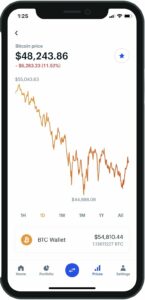
To successfully trade cryptocurrencies, you will likely need to use a cryptocurrency exchange. But what is a cryptocurrency exchange, and how do they work? What are the different types of cryptocurrency exchanges, and how are they different? Let’s take a closer look at these questions and more.
What is a cryptocurrency exchange?
A cryptocurrency exchange is simply an online marketplace where people can buy, sell, and trade cryptocurrencies. If you’ve ever traded stocks or exchange-traded funds (ETFs), you’ve probably used a brokerage. Much like the brokerage platforms (like Vanguard, Schwab, or Fidelity), cryptocurrency exchanges connect buyers and sellers of digital currencies like bitcoin, ethereum, litecoin, cardano, and more.
What kinds of transactions do they facilitate?
Cryptocurrency exchanges facilitate three types of trades. First, you can buy or sell fiat currency (like the U.S. dollar) for a cryptocurrency (like bitcoin). The second option is the inverse, where you can buy or sell cryptocurrency for fiat currency. Lastly, you can use cryptocurrency exchanges to trade cryptocurrencies directly, like buying or selling ethereum with bitcoin).
What kinds of exchanges are there, and how do they work?
The three main types of cryptocurrency exchanges are centralized exchanges, decentralized exchanges, and hybrid exchanges.
Centralized exchanges (CEX)
 Centralized exchanges such as Coinbase, Binance, Kraken, and Gemini are exchanges run by a third-party intermediary, similar to a stock exchange facilitating the purchase and sale of securities.
Centralized exchanges such as Coinbase, Binance, Kraken, and Gemini are exchanges run by a third-party intermediary, similar to a stock exchange facilitating the purchase and sale of securities.
With a CEX, buyers and sellers of cryptocurrency don’t deal directly with each other. Instead, the exchange acts as an intermediary, receiving funds from both parties before executing the appropriate trade. Centralized exchanges simplify trading regular currencies like U.S. dollars and euros and tend to bring a high degree of security, trust, and reputability to crypto trading. CEXs usually demonstrate a willingness to work with government regulators, prioritize consumer protections, and offer fair market pricing. These exchanges know it’s in their best interests to provide superior service to both buyers and sellers because their only business is matchmaking between the two.
In most cases, CEXs require Know Your Customer (KYC) identity verification. KYC allows exchanges and other institutions to reduce the risk of criminal activities like money laundering, tax evasion, identity fraud, and more. While KYC compromises individual user anonymity, it helps protect everyone on the platform and promotes a safer place to trade crypto.
Another feature typically associated with centralized exchanges is the use of hot wallets, which are also typically custodial wallets. A hot wallet is a wallet that’s connected to the internet; with a CEX, these are also custodial wallets, meaning the exchange holds your funds and private keys for you.
Decentralized exchanges (DEX)
A decentralized exchange, such as Uniswap, is a cryptocurrency exchange that allows buyers and sellers to transact directly with one another by utilizing smart contracts. Smart contracts automatically execute an agreement after a particular set of conditions has been verified.
An example of a smart contract might be:
When funds received from User A = 1 BTC
Then transfer 1 BTC from User A to User B
And transfer 13.950715421303 ETH from User B to User A
Smart contracts can establish irreversible actions, which allow cryptocurrencies to be traded anonymously without entrusting any other parties.
DEXs operate without any sort of intermediary and are almost always built on open-source code. This offers transparency to developers, who can analyze the code and collaborate to improve it. Unfortunately, this also means the code running the DEX is transparent to hackers and other bad actors.
Many DEXs only allow trading of cryptocurrencies and do not support buying cryptocurrencies with non-crypto assets (like currencies).
Despite being unable to support fiat currency trades, DEXs offer some distinct benefits to users. Since there’s no centralized server where all users’ personal information and private keys are held, the risk of cyber attack is significantly reduced. In addition, users don’t have to trust a third party which, though unlikely, could commit fraud or leak customer data. Another advantage of DEXs is lower fees, made possible by eliminating the third-party intermediary present on CEXs.
For security purposes, because DEXs aren’t monitored for security the same way CEXs are, DEXs rely heavily on cold wallets – or wallets that are not connected to the internet – to conduct transactions. While a cold wallet protects your crypto, you can’t transfer funds out of cold storage until you connect to the internet. As a result, many people trading on DEXs will use software like MetaMask, which acts as an interface to use your cold storage wallet on DEXs. This process, while safer, does take time, making DEXs slower to trade on compared with CEXs.
Hybrid exchanges (HEX)
As the name suggests, a hybrid exchange seeks to combine the best elements of centralized and decentralized exchanges on a single platform. There isn’t one specific type of hybrid exchange, and each HEX can choose to incorporate different features from centralized and decentralized platforms. In a HEX, users maintain control of their funds through cold wallets.
Like a DEX, HEXs use smart contracts with automated matching protocols, though some third-party involvement can connect buyers and sellers. One example of a hybrid exchange is the multicurrency wallet Eidoo.
A sample trade from each
Centralized exchange: Coinbase

Getting started with Coinbase begins by setting up your account and verifying your email address and phone number. Next, you’ll link a payment method to the account to fund your wallet. Once the funds are available in your wallet, you can place a buy order by selecting a market. For example, this could be trading U.S. dollars for bitcoin. If you place a market order, you’ll be buying the cryptocurrency at its current trading price. On Coinbase, market orders are filled immediately since you agree to buy at the current market price.
Decentralized exchange: Uniswap
The first step in transacting on a DEX like Uniswap is to purchase some ethereum or any other ERC-20 token. Once you have secured your crypto, you can use an interface like MetaMask to actively trade these tokens. With your wallet connected via MetaMask, select the cryptocurrency you want to trade for. Instead of using order books that show buyer and seller offers of available cryptocurrency, Uniswap employs the Automated Market Model (AMM). In this model, smart contracts are used to fill orders automatically. To place your order on Uniswap, simply place a trade, review the settings, and the smart contract will automatically fill your order.
Hybrid exchange: Eidoo
If you want to trade on a hybrid exchange like Eidoo, the first thing you’ll do is download the Eidoo app and open an Eidoo wallet. To fund your Eidoo wallet, you’ll go through the same process of buying ethereum or an ERC-20 token. When you’re ready to trade, select the amount and the crypto you want to swap for. Once you confirm your order, the trade will stay open until the opposite side of your order has been filled.
Future of crypto exchanges
Currently, centralized exchanges like Binance and Coinbase are the most popular platforms for trading crypto. The future, however, seems to point to decentralized and hybrid exchanges increasing in popularity, especially as the technology develops further and becomes more advanced.
The future of crypto exchanges likely lies in existing exchanges offering more trading options, like supporting crypto derivatives and trading of new coins. Additionally, we can expect other platforms to make a foray into the crypto exchange space, much like PayPal did in 2021.
